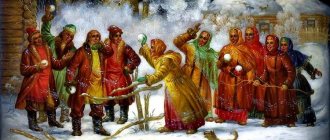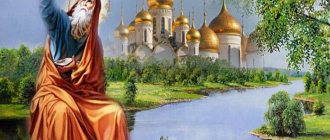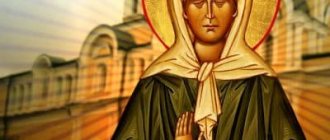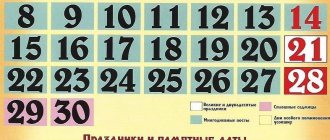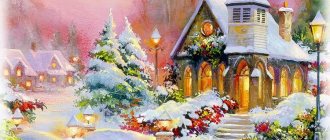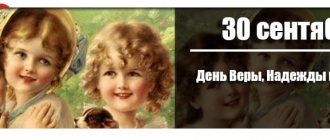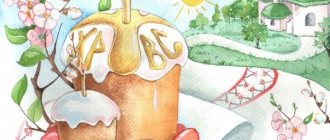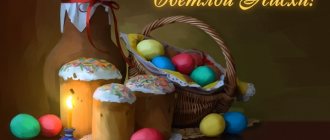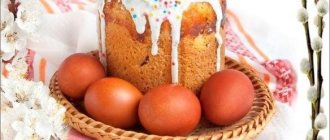The essence of Easter
Originally the death and also the resurrection of Jesus Christ
celebrated every week, while on Friday (the day of fasting and mourning) the sufferings of the Savior were remembered, while Sunday was a day of joy and good news. These celebrations acquired a more solemn character during the Jewish Passover (Passover).
Old Testament Passover
According to legend, God commanded that on the night preceding the 14th day of the first month of the lunar calendar, each Jewish family should sacrifice a young and blameless lamb, whose meat, cooked on the fire, was to be tasted with bitter herbs, as well as unleavened (or leavened) ) bread.
Interesting fact!
When baking leavened bread, two types of dough were used - old (sour) and freshly kneaded, which symbolized the existence that preceded turning to God and life according to the commandments of Jesus Christ.
In addition, God commanded the Israelites to smear the blood of the lamb on the doorposts in order to protect themselves from the terrible punishment of the Lord, caused by the hardening of the heart of the Egyptian Pharaoh, who did not want to let Israel go free. Thus, the destroying angel sent by God visited every Egyptian house and destroyed all the firstborn (and this applied to both people and livestock). But the homes of the Jews, marked with the blood of the Passover lamb, were not touched.
Easter is a moving holiday. Why does the date change?
The date of Easter changes every year. It is directly dependent on the lunar calendar, in contrast to Passover - the Jewish Passover, celebrated according to the solar calendar. The Christian holiday always falls on a Sunday and a full moon. According to custom, the Resurrection of Christ falls on the first resurrection following the new moon - also the first after the spring equinox. As a result, the date of Easter “floats” annually between April 4 and May 8.
The decision to calculate the date of the celebration of Bright Resurrection was made at the Ecumenical Council in the first half of the 4th century. It was guided by the principle that Christian Easter cannot be celebrated before Jewish Passover.
Orthodox Easter
Easter is a holiday that commemorates not only the Resurrection of Jesus Christ
, but also a rebirth to a new life. This is another reason to rethink your life and understand that spiritual fulfillment is much more important than any material wealth.
Easter events are described in all the Gospels without exception. Jesus himself more than once predicted his resurrection on the third day after his martyrdom. When he died, the Jewish high priests, remembering the words of the Savior and fearing the theft of his body by his devoted disciples, on Saturday not only sealed the entrance to the cave where Christ was buried, but also posted a guard near the cave.
On Sunday morning, Mary Magdalene, like other myrrh-bearing women who came to the cave to be anointed with fragrant myrrh before the burial of the Savior, discovered that the entrance to the cave was open. The tomb was empty, while a radiant angel announced that Jesus Christ had risen
.
In honor of the miraculous Resurrection, on the night from Saturday to Sunday, a solemn church service is held, the climax of which is the pre-dawn moment of the ascension to Heaven of the Savior, who has forever acquired Immortality.
From this night, for the next 40 days of celebrating Orthodox Easter, the greeting of people sounds as follows: to the phrase “Christ is Risen” they answer “Truly He is Risen.”
Holy Fire
Just before Easter, on Great Holy Saturday, in Jerusalem, in the Church of the Resurrection on Golgotha (that is the name of the ancient mountain), the descent of the Holy Fire takes place year after year.
It was at this place that, according to testimonies, Jesus Christ was crucified. Here, in a stone cave, he was buried. The Greek Patriarch carries the Holy Fire out of the bowels of the temple and passes the blazing shrine to other clergy. The fire fills the temple, passing from hand to hand of the people present there. Thousands of parishioners flock here at this time from all over the world to become part of and witness this amazing process, which has been reborn every year again and again for many millennia.
Bowls with the Holy Fire are transferred through diplomatic channels to different countries so that every person anywhere in the Christian world can touch this amazing revelation.
Easter: traditions
Traditions for Orthodox Easter:
- Easter service starting at midnight from Saturday to Sunday
- Blessing of food (Easter cakes, leavened bread, eggs, paska, wine, etc.)
- Decorating your home with flowers, such as tulips, daffodils, lilies of the valley, pussy willow, Easter wreaths
- Egg coloring
- Lighting candles that are placed in a central place in the house
- Decorating your home with icons and light images, as well as accessories with elements of Easter decor
- A visit to parents and a joint dinner, which includes a table rich in food, because Lent ends
- Lighting of the Holy Fire, which comes from Jerusalem. A candle lit from this fire and brought home is believed to bring peace, tranquility and happiness.
- Blagovest is the ringing of bells that spreads the good news that Christ is Risen.
It is impossible not to say about such a pre-Easter holiday as Maundy Thursday
. On this day, Easter cakes are baked, eggs are painted, believers confess in churches and take a bath, thereby purifying themselves spiritually and physically. Palm branches are also blessed.
Maundy Thursday is followed by Good Friday
, personifying the suffering of Christ.
From that day until Sunday morning the bells stopped ringing. But on Saturday a solemn church service
, during which the liturgy is read, accompanied by church hymns. On this day you cannot swear or swear.
Important!
When going to church, women should wear a long skirt, tie a scarf on their heads, and use a minimum of makeup. All believers must have a pectoral cross. Remember that church is not a place to attract attention to yourself. On the contrary, here you should behave modestly.
And remember that the main tradition of celebrating Easter
- this is faith in Christ the Savior, which must be truly sincere, and not ostentatious.
How to spend Easter: a festive meal
On the day of Easter, it is necessary to set the table, prepare all kinds of delicious dishes, bake Easter cakes and paint eggs. This tradition originates from ancient times, when fasters rewarded their body and soul for abstaining from worldly pleasures. To do this, they drank kulich - a type of artos, that is, leavened bread. This tradition comes from the origins of Christianity. When reading a common prayer, as during the Last Supper, believers partook of the Body and Blood of Christ. During the meal, the first place at the table was left empty for the invisible Lord, and bread was placed on the chair. It is called a whole prosphora and, just as Christ shared the true bread of life, so it was distributed to those praying. According to the legacy of the traditions of the apostles, church pastors established that on the Resurrection of Christ it is necessary to consecrate bread in the temple. The artos should depict a cross, a crown of thorns, but not without the Crucifixion, for Christ conquered death.
Catholic Easter
The date of celebration of Catholic Easter, like Orthodox Easter, is determined according to the lunar calendar. Catholic Easter in 2020 falls on April 12
(this holiday is always celebrated on the first Sunday after the first full moon).
The traditions of Catholic Easter are in many ways similar to the traditions of the Orthodox holiday. Thus, believers go to church on Saturday to celebrate the all-night service. On Sunday morning, the clergy bless the fire and water (the latter is sprinkled on eggs, as well as all Easter food, while the holy fire is carried home, after which special Easter candles
, cleansing the home from evil).
The morning of Easter Sunday begins with children and young people going around their neighbors' houses, singing songs and congratulating each other on this bright day. The celebration of Easter is not complete without colored eggs, which are thrown at each other, beaten, rolled on inclined planes, and simply exchanged. The Easter bunny brings eggs
.
When adults come from the service, everyone sits down at the festive table, which must include eggs or dishes prepared using them.
During Easter week, believers attend services in churches, and religious performances take place outside.
Easter bunny
Among Catholics, the Easter bunny (or hare) is considered a symbol of Easter
. This animal hides colorful chocolate eggs in its hole for children to find on Easter morning. But! The rabbit brings such sweet gifts only to obedient and well-mannered children.
According to one version, this fairy-tale character laying chocolate eggs was invented by the Germans, and this happened during pagan times (according to them, such beautiful eggs could not be laid by an ordinary chicken).
There is another legend: for example, during the Great Flood, an ark floating on the waves came across a mountain peak, which caused a gap to appear in the bottom of the ship, which the hare plugged with its tail.
There is also an opinion that rabbits that lay eggs thus make amends to people for frequent raids on gardens and vegetable gardens.
In the West, this symbolic image is cultivated everywhere: for example, entire parades are held during which people dress up as bunnies, and stores sell all kinds of accessories, postcards and soft toys in the form of this animal.
When is Easter celebrated in other countries of the world?
In addition to Orthodox Easter, there is also Jewish (Passover) and Catholic. Each of them has its own, separately calculated date. The dates of Easter in Catholicism and Orthodoxy were divided due to different calendars - Julian and Gregorian. The division occurred in 1582, as a result of the Vatican calendar reform, which was not recognized by the Orthodox Church. Catholics and Lutherans will celebrate the Resurrection of Christ in 2021 on April 4.
The Jewish Passover also has a moving date - it is celebrated on the 14th day of Nisan - the spring month, the first in the Old Testament calendar. Passover is celebrated for a week. In 2021, this holiday falls on March 27 – April 4.
Jewish Easter
Passover (or Easter)
- the oldest Jewish holiday associated with the Exodus of the Jews from Egypt and the deliverance of this people from slavery.
Traditionally celebrating Passover
Each year begins, according to the Jewish lunar calendar, on the 14th of the month of Nisan (on the night of this day all Egyptian firstborns died, except for the Jewish ones, since their houses were marked with the blood of sacrificial lambs). It was in memory of the departure of the Jews from Egypt under the leadership of Moses and the fact that death had passed from their homes that the holiday of Passover was named, which is translated from Hebrew as “to pass,” “to go around,” or “to pass by.”
The holiday lasts 7 days. In 2021, Passover begins on April 8 and ends on April 16.
Passover for Israelis is a time of mass excursions and pilgrimages to Jerusalem.
Traditions of Jewish Passover
- Collecting all leaven (that has gone through the fermentation process) before Passover and burning what was collected on the morning before the holiday
- Eating matzah - unleavened flatbread made from unleavened dough, which is baked in memory of the Jews who hastily left Egypt and took with them bread that they did not have time to leaven, and therefore it was unleavened
- Fasting of first-born men in memory of the first-born of Israel saved in Egypt
- Weekends on the 1st and 7th days of Passover (you can work on other days, although with restrictions)
- Conducting solemn services on the first night, as well as on the first two days of Easter.
Family meals deserve special attention
in the evening of the 14th of Nisan, with which Passover begins. Thus, during the meal, each person drinks 4 glasses of wine, which symbolizes the four cups spoken of in the Torah. There must be matzo on the table (two or three matzos are laid out one on top of the other).
Also present at the festive table:
- chicken eggs and wings representing the sacrificial lamb,
- a container of salt water is a symbol of the tears of the Israelites who endured slavery,
- bitter herbs (for example, celery or horseradish),
- charoset (a sweet mixture consisting of fruits, nuts, as well as wine and flour) is a memory of clay (it was from which the Jews made bricks as Egyptian slaves).
At the end of dinner, the front door opens, thereby symbolizing the beginning of the exodus of the children of Israel from Egypt.
On the last day of Easter, a prayer of remembrance of the dead is read in synagogues. Also traditionally on this day, Jews go to a pond and sing a passage from the Torah, which is dedicated to the events of the Exodus.
History of the holiday and symbols (origins)
The history of the main holiday of believers goes back not two thousand years, but more than three, or even five. And this is only what is considered “legalized” in the holy writings - without regard to pagan rituals, which coincide in the cyclicity of celebrations with the Solemnity of celebrations and some similarity of ritual rites.
The official (Christian) Passover roots are inextricable from Israeli history. With those Old Testament times, when the people of the earthly mother of Jesus - the Virgin Mary - had been groaning under the heel of Egyptian slavery for 400 years, suffering from persecution and genocide.
Jews in Egyptian slavery
History before Christ
Pesach - Piskha - Easter in literal translation from Jewish means “transition”, “to pass by”, in artistic translation it means “deliverance”. This is the day of the exodus of the Jewish people from Egypt - liberation from slavery. On the day of his departure from Egypt. But Pharaoh did not simply take and release the slaves of his own free will or, succumbing to the persuasion of Moses, who led the Jews to look for the Promised Land, but was forced to do this after suffering ten Egyptian plagues. The last straw in favor of his decision was the death of all the first-born sons born on Egyptian soil. But Jewish homes passed this disaster. The doorposts of their houses were sprinkled with the blood of sacrificial lambs.
On the tables at the last meal of the Jews on Egyptian soil there were dishes with lambs baked with herbs. They have become a traditional Passover dish.
Easter lamb
Moses, who led the people through the desert for forty years, cried out to God and heard the voice of God. From him he brought the ten fundamental commandments of God to the people of Israel. Jesus put these commandments into practice.
In 33 AD, on the eve of his capture and all the subsequent ordeals (coinciding with the Holy Week of Great Lent), Jesus Christ, together with the apostles, celebrated Pishu. According to the laws of that time, the meanings of the dishes were as follows: red wine - a symbol of the blood of a sacrificial lamb, bread (unleavened), flavored with bitter herbs - as a sign of the bitterness and deprivation of centuries-old slavery. But he, anticipating his death, breathed into them a different content: the bread was his body, broken for people, the cup of wine was the blood shed by him to atone for human sins.
First Communion from the hands of Christ himself
The lamb was a pagan sacrifice, the Messiah was God's lamb. His crucifixion is a “contract” between the Lord and humanity, according to which the Sacrifice of the Cross was accepted, and the Savior was resurrected on the third day after physical death. Died as a man, and returned to eternal life by God. Easter is a symbol of the transition to immortal life.
Holy Fire
After the body of the son of the Virgin Mary was removed from the cross, he was transferred to a cave, the tomb was locked with a large, motionless stone with a seal placed on it. It was impossible to enter or leave it. Pontius Pilate's soldiers guarded her around the clock. The disciples of Christ came to the mountain every day. But the most devoted one - the Apostle Paul - visited her both day and night. According to legend, it was he who was given a sacred sign - the deep darkness was suddenly illuminated by an unearthly glow. So the Lord declared his presence, bringing good news - about the triumph of life over death. And indeed, in the morning the body of the Messiah was not found in the crypt. He left it, passing through the stone and the guards.
Later, the Church of the Resurrection of the Lord was built on the site of the tomb, and every year the lamps on its altar spontaneously ignite on the eve of the date of the resurrection of the Messiah. This fire is material proof of the existence of God. His name is the Gracious One. It is not similar to any known heat source in our world.
According to legend, Christ left it to humanity as an edifying symbol of eternal life. The flame must flare up every year until the end of time - until people lose faith in the Lord. If it goes out, the end of the world will come. Christ will return again to the sinful earth and will carry out Judgment.
Easter bunny
If Easter, as a Christian festival, originated in the east, then one of the proofs that its predecessor in the west was paganism is the lop-eared symbol of the main part of Catholic Europe and Protestant America - the Easter bunny. He makes nests, placing magic eggs there, and then gives colorful (and sweet chocolate treats) gifts to obedient children.
The roots of the pedigree of such an unusual beast were found in the ancient myths of the ancient Germanic tribes, dedicated to the meeting of the spring equinox. The main characters of the ritual actions that marked the change of seasons were the eternally young goddess Ostara and her assistant, the rabbit (hare). He announced her arrival and showed her the way - loudly beating a drum with his paws, and the offspring were born with incredible speed, demonstrating that the time of fertility had come. Its fertility was captured in the form of an egg - an eternal symbol of the origin of life in an essentially non-living object.
Christianity, displacing paganism in Europe, replaced some gods with others, rewrote traditions, but was not able to completely eradicate them. The name of the goddess began to be forgotten, but the magic rabbit, which stores sweet spring fruits, became too tightly integrated into folklore songs and jokes. And it is much easier to meet a living rabbit, which becomes active in the spring, than a goddess. So it leaked out to Catholics on Easter. And then, with the European colonialists who seized the lands discovered by Columbus, he moved to America and settled securely there.
Eggs
For the ancient Egyptians, Slavs, Greeks, Persians, Scythians, and Romans, the egg was originally a sacred symbol of new life. Many tribes and nationalities believed that the universe itself originated from the bestowing birth of all things - the egg. One of the Slavic epics says that the earth appeared from one of its parts, and the sky from the other. In the spring “spell rituals” they were painted, painted, and decorated with symbols reflecting the picture of the triune world - heavenly, earthly and underground.
In addition to the pagan background of the Easter symbol, there is also a Christian one. According to legend, the follower of Jesus, Mary Magdalene, was one of the first to believe in the resurrection of Christ and brought this good news to the Roman emperor. Announcing the divine miracle, she handed Tiberius a white chicken egg as a gift. The Great Pontiff laughed at the myrrh-bearer, pointing out that the white shell of the egg would soon turn scarlet, before the news of the resurrection would turn out to be true. And God showed a miracle - the egg turned red. This is how the tradition of painting eggs in life-affirming colors was born.
Kulich
Tall, rounded Easter bread is a traditional sweet pastry on the tables of followers of the teachings of Christ. The main dish, clearly associated with the main Christian holiday. But its origin story is much older than Christianity.
Kulich is the embodiment of Jesus Christ himself, who became spiritual bread, giving eternal life to the soul of saved humanity turned to God. And the first shepherds of the Christian faith established that on the lectern in the temple (on the day of the resurrection of the Son of God) they would place leavened bread (artos, with the image of a cross with a crown of thorns, but not the Crucified One) - the image of the Messiah, invisibly present in our lives.
Artos
Fasting before Easter
The fast before Easter lasts 7 weeks
, during which believers adhere to strict dietary rules. Let us immediately note that for an unprepared person such abstinence can be a difficult test, so you need to be patient and tune in to a positive outcome of this undertaking.
Lent
- a time when each of us, having given up pleasures, can rethink and reassess life values.
But!
Fasting should not harm your health, so it is recommended to consult your doctor before taking it.
Fasting is contraindicated
the following categories of persons:
- Suffering from peptic ulcers
- With disorders of the gastrointestinal tract
- To old people
- Pregnant and lactating.
If you are not completely ready to give up Fasting, then you can make it less strict so as not to limit the intake of necessary vitamins and nutrients into the body.
Easter and Maslenitsa in 2021
Orthodox Easter is preceded by the holiday Maslenitsa. According to the church calendar, Maslenitsa week is called “Cheese Week”. During this period, believers prepare for Lent before Easter. The timing of Maslenitsa week varies every year depending on the date of Easter. In order to find out when Maslenitsa will be, it is enough to subtract 56 days from the date of Easter: these are 48 days of Lent and the week of Maslenitsa itself. Thus, in 2021, the end of Maslenitsa falls on March 14, and the beginning is March 8.
What can you eat for Easter
Easter meal
– one of the most pleasant parts of Easter. Moreover, it begins with blessed products brought from the church - Easter cakes, colored eggs, etc. But it is better not to get carried away with alcoholic beverages - a few glasses of wine are enough to break the fast.
Easter cake (paska)
- personification of Jesus Christ. This pastry with raisins and nuts does not spoil throughout the 40 days of Easter, provided that the Easter cake is properly prepared.
Curd sweet paska
- a prototype of the Kingdom of Heaven, a symbol of endless joy, the bliss of the saints, as well as the sweetness of heavenly life. The shape of the baked goods in the form of a mountain is the foundation of the heavenly Jerusalem.
Painted eggs (krashenki)
- a symbol of rebirth and the birth of new life.
Important!
If you adhered to Lent, then do not eat savory dishes with greed, but, on the contrary, eat them with joy and gratitude.
What foods can you eat during Lent?
In the first, fourth and seventh weeks you can only eat dry food
, unseasoned with sauce or butter. In addition, dishes must be cold (food cannot be reheated).
During the remaining weeks, you are allowed to eat boiled vegetables.
, as well as other lean products prepared in the same way.
The first four days and the last week before Easter are considered the most strict periods of Lent. On the first day of Lent and on the last Friday before Easter, you cannot eat at all (you are only allowed to drink water). On the first Friday of Lent, you can eat boiled wheat, slightly sweetened with honey or sugar.
On Good Friday
You can only eat
dry food
.
Saturday before Easter
It is allowed to eat
boiled foods
.
Traditions of celebrating Christ's Resurrection
The Resurrection of Christ is a holiday when squabbles and discord are forgotten and people remember that there is something more in this world... Isn’t that why these ancient Easter traditions are performed with such reverent consistency from year to year all over the world?..
What do people do on Easter? It’s different in different countries. More precisely, it’s the same thing, but in different ways. Traditional symbols of Easter are, first of all, colored eggs (and in England and some European countries, for example, chocolate eggs); baked Easter cakes, cottage cheese Easter cakes.
I already told once on the pages of one of my blogs how Easter dinner took place in one of the old houses of a Russian emigrant in Seoul. I think it will be interesting to know about this too.
Well, returning to our topic, I’ll add that people prepare all these festive dishes on the eve of the holiday and bring them to the Easter service in the church to be blessed by the priest. And only after this, at the end of the solemn ceremony of the Easter service, people return to their homes and begin the festive dinner (or breakfast).
Easter symbols
All dishes of the festive meal and the Easter table are, in fact, one or another Easter symbols. Lush, elastic Easter cakes and special bread - artos are baked from yeast dough: the sour leaven dough from which it is baked seems to be restored again, coming to life in the hands of the hostess...
Painted eggs are a symbol based on ancient biblical history, when Mary Magdalene, wanting to inform Emperor Tiberius about the Resurrection of Christ, brought him an ordinary egg as a gift. Tiberius, naturally, doubted that the Resurrection was possible in principle, comparing the situation, again, to a white egg that cannot turn red overnight...
But - this is exactly what happened before his eyes: Maria’s gift in the hands of Tiberius turned red...
In addition, the egg itself in Easter symbolism is a symbol of new life: the coffin is a shell, and a new being is inside the egg. And, of course, on holidays it is customary to decorate clean houses with flowers also blessed in the church.
Eggs for Easter
Painted eggs
- a traditional product of the Easter holiday table. Eggs are the first to be eaten at the Easter meal; they are distributed to relatives, neighbors, and the poor. Eggs are painted on Maundy Thursday.
There are several legends that explain the tradition of dyeing eggs for Easter.
.
According to one of them, it was the egg that was presented to the Roman Emperor Tiberius by Mary Magdalene, who told the ruler about the Resurrection of Jesus. The story was accompanied by a miracle: so, before Tiberius’s eyes, the egg turned red, thereby personifying the blood shed on the cross by the Savior.
According to another version, the Virgin Mary specially painted eggs in order to entertain her little son.
Another legend says that one day one of the seven old Jews who gathered for a meal predicted that in 3 days Jesus would rise again. But the owner of the house did not believe the Jew and said that such a miracle would happen if the fried chicken ran and the eggs turned red. At the same moment, the chicken came to life, and the eggs turned red.
How to paint eggs?
Breaking the fast is an important holiday custom. Traditionally, the first thing to eat is a boiled egg. It is painted in Easter traditions. The egg is a symbol of the Holy Sepulcher, where eternal life is hidden. The coloring of eggs and their blessing are part of the ritual of the Sunday meal. The shell symbolizes the stone that was used to cover the entrance to the rock - the burial place of the Savior. It contains new life. The coloring of eggs is also not accidental. According to the canon, they should be red or crimson, like the blood shed by Christ. Traditionally, eggs are colored with onion skins. Its rich color gives the desired shade. The shell is painted with paints and patterns based on biblical motifs. Nowadays, quick stickers are used to wrap the egg.
The egg is a symbol of the Holy Sepulcher, where eternal life is hidden
What not to eat on Easter
Foods to avoid during Lent:
- Meat and any meat products
- Baking and sweets
- Fish and any fish products (the exception is non-strict days on which you can deviate from the strict rules of Lent)
- Bird
- Butter
- Eggs
- Fast food products
- Milk and dairy products
- Alcoholic drinks.
In addition, you should limit the consumption of spices, salt, sugar and fried foods as much as possible during Lent.
It is important not to overeat during Lent, remembering that the main task at this time is to spiritually cleanse yourself.
What prayer is read at the cemetery on memorial day?
Coming to the cemetery, a layman must immediately do two things - light a funeral candle and read a funeral prayer. This memorial prayer is called litiya.
Separately, the prayers of parents for deceased children, of a widow or widower for a spouse, of children for a deceased parent, or simply a memorial prayer for a deceased Christian are read.
There is a wrong tradition of wishing the earth to rest in peace to the deceased. Why you can’t do this can be read in this article.
Litiya rite read at the cemetery:
Through the prayers of the saints, our fathers, Lord Jesus Christ our God, have mercy on us. Amen. Glory to Thee, our God, glory to Thee. Heavenly King, Comforter, Soul of Truth, Who is everywhere and fulfills everything. Treasure of good things and life to the Giver, come and dwell in us, and cleanse us from all filth, and save, O Blessed One, our souls. Holy God, Holy Mighty, Holy Immortal, have mercy on us.
(Read three times, with the sign of the cross and bow from the waist.)
Glory to the Father and the Son and the Holy Spirit, now and ever and unto ages of ages. Amen. Most Holy Trinity, have mercy on us; Lord, cleanse our sins; Master, forgive our iniquities; Holy One, visit and heal our infirmities, for Thy name's sake. Lord have mercy.
(Thrice.)
Glory to the Father and the Son and the Holy Spirit, now and ever and unto ages of ages. Amen. Our Father, who art in heaven! Hallowed be Thy name, Thy kingdom come, Thy will be done, as it is in heaven and on earth. Give us this day our daily bread; and forgive us our debts, just as we forgive our debtors; and do not lead us into temptation, but deliver us from the evil one.
Lord have mercy. (12 times.)
Come, let us worship our King God. (Bow.)
Come, let us worship and fall down before Christ, our King God. (Bow.)
Come, let us bow and fall down to Christ Himself, the King and our God. (Bow.)
Dates of Ecumenical Parental Saturdays
There are several special days of remembrance, on which the church commemorates all the deceased who died a sudden death, soldiers who were not guided by Christian prayers before their death, and of course those who were honored with a Christian death.
On such days, memorial services are held, and the days themselves are called Ecumenical Parental Saturdays. These memorial days are moveable, since they are tied to one or another church holiday.
What not to do during Lent
Restrictions during Lent affect not only the food basket, but also the lifestyle in general. But such changes are designed to make a person better, help him find himself and find peace of mind.
During Lent it is prohibited:
- Use profanity
- Thinking badly about others
- Slander
- Wishing people harm and treating them with hatred and aggression
- Visit gambling and entertainment establishments
- Take stimulant medications
- Smoking
- Read literature that arouses unclean thoughts and desires
- Be lazy on weekdays and work on Sunday.
Easter is an opportunity to gain Immortality through good deeds and pure thoughts.
Why does everyone go to the cemetery on a memorial day?
Since ancient times, the custom has arisen to mark the burial place of the dead. It existed among almost all peoples in one form or another. In Christianity, it is customary to mark the burial place with a mound of earth with a cross erected over it, as a symbol of faith, a symbol of the Lord, a symbol of the coming rebirth. The cross shows us that if the body of the deceased is in the grave, then his soul is in Heaven.
After all, in Christianity it is customary to call the dead the deceased, as a sign that they have not left us forever, but at the time determined by God they will certainly rise. And the grave is the place of resurrection of each of the deceased. And it is our sacred duty to keep this place of future resurrection clean and orderly.
People close to us remain forever in our hearts, even if they are no longer with us. And to express their love, respect, recognition to them, people go to the cemetery. After all, the cemetery is a place of meetings, grief and memories.
Each person decides for himself when and how many times a year to visit the graves of deceased relatives. Most often, visits to the cemetery are carried out on days of remembrance of the dead, but each person also has his own mournful date, during which he can and should visit the cemetery and pray for the soul of a loved one.
